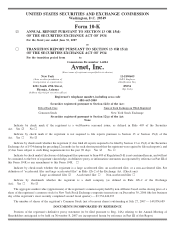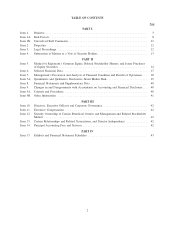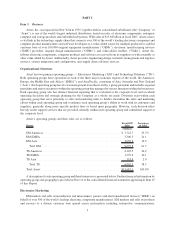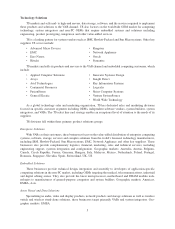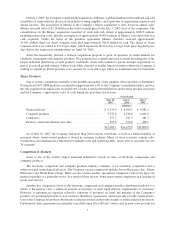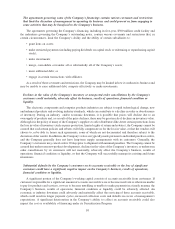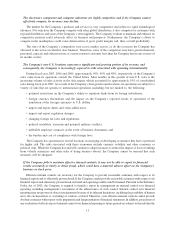Avnet 2007 Annual Report Download - page 11
Download and view the complete annual report
Please find page 11 of the 2007 Avnet annual report below. You can navigate through the pages in the report by either clicking on the pages listed below, or by using the keyword search tool below to find specific information within the annual report.The electronics component and computer industries are highly competitive and if the Company cannot
effectively compete, its revenues may decline.
The market for the Company’s products and services is very competitive and subject to rapid technological
advances. Not only does the Company compete with other global distributors, it also competes for customers with
regional distributors and some of the Company’s own suppliers. The Company’s failure to maintain and enhance its
competitive position could adversely affect its business and prospects. Furthermore, the Company’s efforts to
compete in the marketplace could cause deterioration of gross profit margins and, thus, overall profitability.
The sizes of the Company’s competitors vary across market sectors, as do the resources the Company has
allocated to the sectors in which it does business. Therefore, some of the competitors may have greater financial,
personnel, capacity and other resources or a more extensive customer base than the Company has in one or more of
its market sectors.
The Company’s non-U.S. locations represent a significant and growing portion of its revenue, and
consequently, the Company is increasingly exposed to risks associated with operating internationally.
During fiscal year 2007, 2006 and 2005, approximately 50%, 49% and 48%, respectively, of the Company’s
sales came from its operations outside the United States. Most notable in this growth of non-U.S. sales is the
increasing volume of sales activity in the Asia region, which accounted for approximately 19% of consolidated
sales during fiscal year 2007. As a result of the Company’s foreign sales and locations, its operations are subject to a
variety of risks that are specific to international operations, including, but not limited to, the following:
• potential restrictions on the Company’s ability to repatriate funds from its foreign subsidiaries;
• foreign currency fluctuations and the impact on the Company’s reported results of operations of the
translation of the foreign currencies to U.S. dollars;
• import and export duties and value-added taxes;
• import and export regulation changes;
• changing foreign tax laws and regulations;
• political instability, terrorism and potential military conflicts;
• inflexible employee contracts in the event of business downturns; and
• the burden and cost of compliance with foreign laws.
The Company has operations in several locations in emerging or developing economies that have a potential
for higher risk. The risks associated with these economies include currency volatility and other economic or
political risks. While the Company has and will continue to adopt measures to reduce the impact of losses resulting
from volatile currencies and other risks of doing business abroad, the Company cannot be ensured that such
measures will be adequate.
If the Company fails to maintain effective internal controls, it may not be able to report its financial
results accurately or timely or detect fraud, which could have a material adverse effect on the Company’s
business or stock price.
Effective internal controls are necessary for the Company to provide reasonable assurance with respect to its
financial reports and to effectively prevent fraud. If the Company cannot provide reasonable assurance with respect to its
financial reports and effectively prevent fraud, its brand and operating results could be harmed. Pursuant to the Sarbanes-
Oxley Act of 2002, the Company is required to furnish a report by management on internal control over financial
reporting, including management’s assessment of the effectiveness of such control. Internal control over financial
reporting may not prevent or detect misstatements because of its inherent limitations, including the possibility of human
error, the circumvention or overriding of controls, or fraud. Therefore, even effective internal controls cannot provide
absolute assurance with respect to the preparation and fair presentation of financial statements. In addition, projections of
any evaluation of effectiveness of internal control over financial reporting to future periods are subject to the risk that the
11

